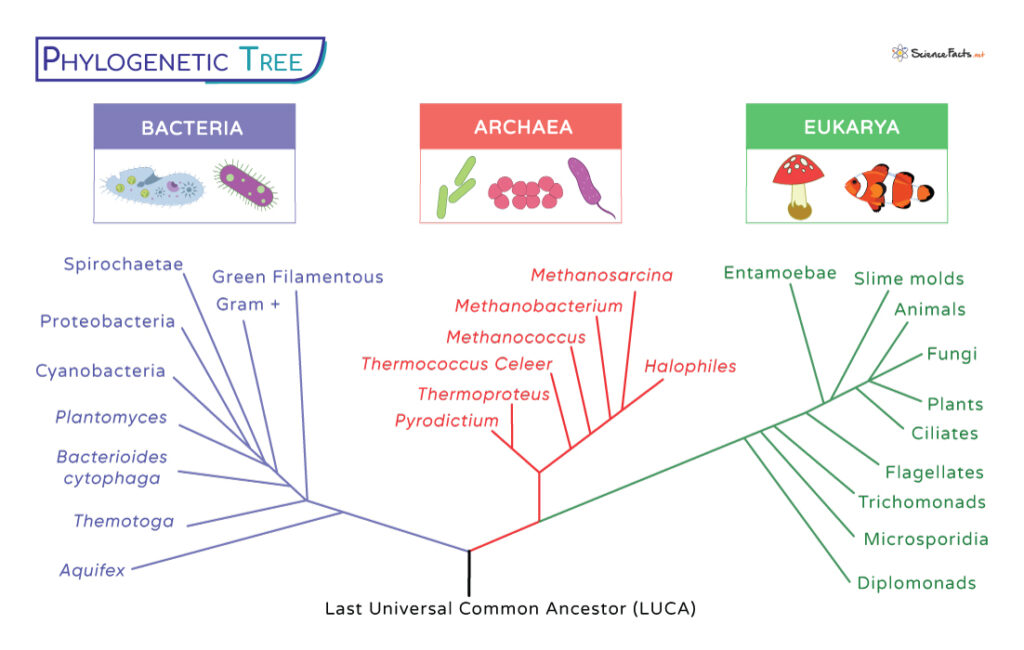Scientists who study phylogeny find patterns of shared ancestry between lineages. They are built based on hypotheses supported by facts. Most modern classification systems use phylogenetics to develop relationships among unknown organisms. Phylogenetics (phylogeny) comes from the Greek words ‘phûlon’, which means ‘race or lineage,’ and ‘genesis,’ which means origin. They have been used to study evolutionary relationships among organisms since the time of Charles Darwin.
How to Read an Evolutionary Tree
A clade can be of different types:
Types
How to Make a Phylogenetic Tree
Importance of Phylogenetic Trees
Root (Node), Common Ancestor, and Taxa
In a phylogenetic tree, the common ancestor (a species or a group) is found at the tip of the tree’s branches. The pattern in which the branches connect gives an idea of where and how the evolution of those species from their common ancestor occurred. At each branch point, known as the root node, lies their recent common ancestor. Thus, a branch point represents a divergent evolution, where a single group diversified into two or more different species. The diagram below shows a simple phylogenetic tree having four taxa: A, B, C, and D. All four taxa have a common ancestor from where the tree branches out into two. Both the group divides further into two more types, each again having a common ancestor.
Sister Group and Outgroup
A taxon outside the group of interest is called an outgroup. They arise from the base of the tree. All members within a group are more closely related than they are to the outgroup. When two lineages develop from the same branch point, they are called sister groups or taxa. In Figure 1b, A and B are a sister group, while C is an outgroup of A and B.
Basal Taxon and Polytomy
A lineage that branched early from the root and remains unbranched is called a basal taxon or group. A branch with more than two lineages is called a polytomy. In Figure 1c, A and B comprise a sister group; C, D, and E are polytomy, and E is a basal taxon.
Which Species is More Related
In Figure 1a, A, B, C, and D are four species that diverged from a common ancestral root at some point and, thus, are highly related. The reason is that moving backward in the tree, we first reach their immediate common ancestor. Each horizontal line in a phylogenetic tree represents a series of ancestors that lead up to the species at its end. Here, if we move back through A and B, we will get their branch point. The same is the case with C and D. In contrast, B converges with C only after its junction point with A. The same is the case with B and D, A and C, and A and D, and thus, they are distantly related. However, we cannot conclude if A and B are more closely related to each other than C and D, as the horizontal axis does not directly correspond to time. Phylogenetic trees can also look different. In all the trees in Figure 1, since their branching patterns or relatedness are similar, A, B, C, and D have the same relationship.
Clades in a Phylogenetic Tree
From a phylogenetic tree, we can conclude if a group of lineages forms a clade. A clade is a group of taxa within the phylogenetic tree, including a common ancestor and all its descendants (living or dead). Thus, A and B, with its immediate root, form a clade, while C and D, with its root, form another clade.
1. Cladograms
The phylogenetic tree built on clades is called a cladogram. It shows only the branching pattern but does not represent time or relative change in character over time.
2. Phylograms
Compared to cladograms, phylograms have scaled branches that show time or relative change in character over time.
Other Types
Rooted Phylogenetic Tree A rooted phylogenetic tree is a tree that has a common node or root among the species represented by the leaves. The root node lacks a parent node but is the parent node for all other tree nodes. All the phylogenetic tree diagrams shown are in rooted form. The diagram below shows a rooted phylogenetic tree with three domains of life: Bacteria, Archaea, and Eukarya. Unrooted Phylogenetic Tree An unrooted phylogenetic tree is the opposite of a rooted tree, as they do not have a common root. They illustrate the relatedness of the leaf nodes without any idea about their ancestry. An unrooted tree is also obtained from a rooted tree by omitting the root. The diagram below shows an unrooted phylogenetic tree. Bifurcating and Multifurcating Phylogenetic Tree Rooted and unrooted phylogenetic trees can be bifurcating or multifurcating in nature. A rooted or unrooted bifurcating tree has two branches while multifurcating trees have more than two branches. Also, phylogenetic trees can be labeled one or unlabeled. A labeled phylogenetic tree has specific values assigned to its leaves, while an unlabeled tree defines only its topology. These data find homology (similarity due to common ancestry) among living organisms: plants or animals. For example, all human beings have large brains and possess hairs in their bodies, similar to our ancestors. Again, all mammals produce milk from their mammary gland. Phylogenetic trees are drawn using the principle of parsimony, which says that the most likely pattern requires the fewest changes. For example, the body hairs in present-day man are assumed to be because their ancestors had body hairs rather than multiple groups of organisms, each independently developing them. Also, starting with a single species and tracing back towards the ‘trunk’ of the tree, we can identify its ancestor and where lineages share a common ancestry. Thus, phylogenies are a fundamental tool for organizing knowledge on biodiversity on Earth.
